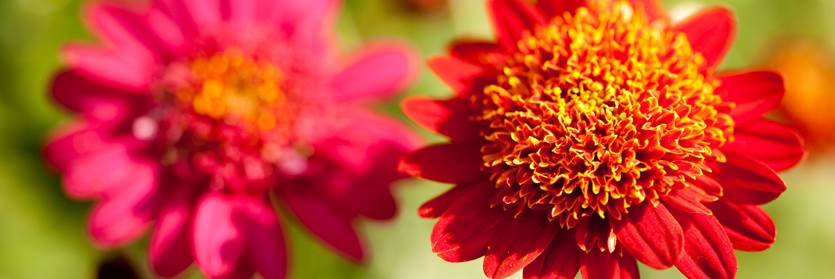Inside The New York Botanical Garden
Plant Talk
Posted in Learning Experiences on June 8 2010, by Plant Talk
See Life More Leisurely Through Botanical Illustration Study
 |
Rose Marie James is an instructor in the Garden’s Botanical Art and Illustration program. |
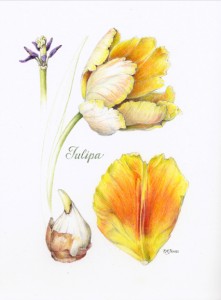 What started me thinking about what I call “slow art” is my affinity for “slow food” (I must confess to a McDonald’s fix on occasion). Engaging in the preparation of food is a more meaningful experience for me than driving through a pick-up window or popping something into the microwave.
What started me thinking about what I call “slow art” is my affinity for “slow food” (I must confess to a McDonald’s fix on occasion). Engaging in the preparation of food is a more meaningful experience for me than driving through a pick-up window or popping something into the microwave.
Knowing what a bean looks like before it gets cut up, handling a whole head of lettuce that needs washing and tearing into bite-size pieces, trimming the greens and roots from a beet before cooking remind me that I am connected to and rely on plants to thrive. Additionally, eating food that is carefully prepared is both satisfying and delicious.
That same kind of connection between process and result is the reason I love working as a botanical artist, and have, therefore, come to see it as “slow art.”
It contrasts with the work I have done as a graphic designer in promotional advertising, where everything has to be done in a hurry. Using the computer to this purpose just amplifies the frenzy, leaving time for little but making things look good.
Read More
Posted in Emily Dickinson, Exhibitions on June 4 2010, by Plant Talk
Reclusive Poet’s Surviving Garment on Display in Library Gallery
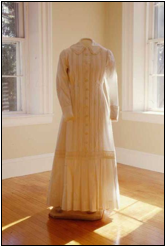 “A step like a pattering child’s in entry & in glided a little plain woman with two smooth bands of reddish hair . . . in a very plain & exquisitely white pique & a blue net worsted shawl.” This description Thomas Wentworth Higginson sent to his wife in 1870 has been pinned to Emily Dickinson for nearly 150 years. Mabel Loomis Todd heard about “the character” of Amherst almost as soon as she set foot in town in 1881: She “seems to be the climax of all the family oddity. . . . She dresses wholly in white, & her mind is said to be perfectly wonderful.” (Photo: Emily Dickinson dress, ca. 1878–82; white dress (reproduction), Emily Dickinson Museum Collection. Original, Amherst History Museum collection)
“A step like a pattering child’s in entry & in glided a little plain woman with two smooth bands of reddish hair . . . in a very plain & exquisitely white pique & a blue net worsted shawl.” This description Thomas Wentworth Higginson sent to his wife in 1870 has been pinned to Emily Dickinson for nearly 150 years. Mabel Loomis Todd heard about “the character” of Amherst almost as soon as she set foot in town in 1881: She “seems to be the climax of all the family oddity. . . . She dresses wholly in white, & her mind is said to be perfectly wonderful.” (Photo: Emily Dickinson dress, ca. 1878–82; white dress (reproduction), Emily Dickinson Museum Collection. Original, Amherst History Museum collection)
These contemporary accounts have fixed a compelling image through the decades of, well, oddity. Poetic genius is different from the norm. But odd, isn’t it, that the only full garment known to have belonged to Emily Dickinson and surviving to the present day is one white dress? This iconic garment belongs to the Amherst Historical Society, an exact replica is always on display at the Dickinson Homestead (now part of the Emily Dickinson Museum) in Amherst, and now one is on view in the LuEsther T. Mertz Library Gallery as part of the exhibition Emily Dickinson’s Garden: The Poetry of Flowers.
Read More
Posted in Exhibitions on June 3 2010, by Plant Talk
Gallery Exhibition Delves into Poet’s Love of Nature
 |
Judith Farr is Professor Emerita of English and American Literature at Georgetown University and author of The Passion of Emily Dickinson and The Gardens of Emily Dickinson. |
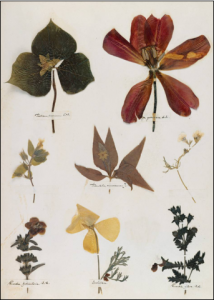 It is not widely known that our great American poet Emily Dickinson (1830–1886) was a practiced gardener before she became an accomplished poet. She joined her gentle mother tending the classic contents of a cottage garden—roses, cyclamen, lobelia, tulips, and more—at only 12 years of age while her training under the famous New England educator Edward Hitchcock taught her the elements of botany in childhood.
It is not widely known that our great American poet Emily Dickinson (1830–1886) was a practiced gardener before she became an accomplished poet. She joined her gentle mother tending the classic contents of a cottage garden—roses, cyclamen, lobelia, tulips, and more—at only 12 years of age while her training under the famous New England educator Edward Hitchcock taught her the elements of botany in childhood.
Indeed, nearly half of Dickinson’s lyrical letters to family and chosen friends and over one-third of her brilliantly idiosyncratic poems appeal to nature for the images and themes that render them incisive and unforgettable. Only a few of Emily Dickinson’s poems were printed during her lifetime but many people remembered receiving one of them, often tucked into an exquisite bouquet that she had grown and arranged herself.
Therefore, it is fitting that The New York Botanical Garden presents Emily Dickinson in her reciprocal roles as Poet and Gardener in its exhibition Emily Dickinson’s Garden: The Poetry of Flowers. While an array of the flowers about which she wrote blooms outdoors at the Garden, the LuEsther T. Mertz Library Gallery showcases materials designed to introduce visitors to the life and art of Emily Dickinson. The Gallery Exhibition, which will run to August 1, is built around several significant themes in Dickinson’s life, such as her childhood, her gardening, and her poetry.
Read More
Posted in Science on June 2 2010, by Plant Talk
 |
Wayt Thomas, Ph.D., is the Elizabeth G. Britton Curator of Botany in the Institute of Systematic Botany. |
Editor’s note: Botanical Garden scientist Dr. Wayt Thomas has been filing reports from the field in northeastern Brazil, where he has studied the flora of the Atlantic coastal forest for 20 years. Read his earlier posts from this trip.
Wednesday, 12 May (Continued): We went back to Serra Grande and had dinner with Daniel; we went to the central plaza in town and had acarajé, a Bahian specialty with African origins, and not for the diet conscious. It is a dumpling made of chickpea meal deep-fried in dendê (African oil palm) oil. After it is fried, it is split open and slathered with a combination of other Bahian specialties, including dried shrimp, salad, vatapá (another dish of African origin made of bread pudding with shrimp, coconut milk, peanuts and cashews), and hot pepper paste.
Thursday, 13 May: Today we started for the town of Jequié, but with a planned detour on the way. Leaving Serra Grande, we headed north toward the beach resort town of Itacaré, and then over the new bridge crossing the Rio de Contas (Pebble River). We turned east toward the Marau Peninsula, an area of intense beachfront development and, consequently, increasingly threatened native vegetation. The sandy savannas near the coast are called restingas and harbor a fascinating array of species, some also found in Brazil’s central highlands, others unique to Marau. In some cases, the restinga sands support forests—these, too, are home to fascinating species such as Griffinia espiritense, a lily with beautiful green-and-pink mottled leaves, or the strange Anthurium bromelicola, a slender vine that grows only out of the center of terrestrial tank bromeliads.
The town of Jequié is at the western edge of the coastal forest, at the boundary between forest and dry thorn scrub known as caatinga (it means “white forest,” which is what it looks like when it has lost its leaves). One of our collaborators, Dr. Guadalupe Macedo, is a professor at the State University of Southern Bahia, in Jequié. We drove the four hours west from Marau to Jequié to meet with her to discuss our joint project.
Read More
Posted in Emily Dickinson, Exhibitions on May 28 2010, by Plant Talk
 |
Noelle V. Dor is Museum Education Intern in the Everett Children’s Adventure Garden. |
The delicate unfurling of fresh leaves…
The kaleidoscopic flowering of plants small and large…
The courtship dances of birds and bees…
The cycling of sunshine and rain to nourish new life…
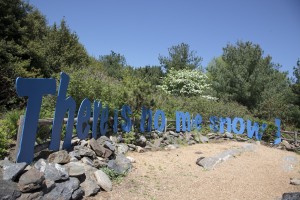 There is hardly a more poetic season than spring. All of nature is waking up and bursting forth in variously colored, scented, textured, and melodic ways. It’s no wonder that we, too, are moved to find refreshment for our own lives. When immersed in a space of natural beauty and vitality, some of us are even motivated to translate those experiences into artistic expressions. Inspired by well-versed poet and gardener Emily Dickinson, the Everett Children’s Adventure Garden has seamlessly blended nature and art to spark this dynamically creative process among visitors to the exhibition Emily Dickinson’s Garden: The Poetry of Flowers.
There is hardly a more poetic season than spring. All of nature is waking up and bursting forth in variously colored, scented, textured, and melodic ways. It’s no wonder that we, too, are moved to find refreshment for our own lives. When immersed in a space of natural beauty and vitality, some of us are even motivated to translate those experiences into artistic expressions. Inspired by well-versed poet and gardener Emily Dickinson, the Everett Children’s Adventure Garden has seamlessly blended nature and art to spark this dynamically creative process among visitors to the exhibition Emily Dickinson’s Garden: The Poetry of Flowers.
Read More
Posted in Learning Experiences on May 27 2010, by Plant Talk
Kids Learn Science Through Virtual Exploration of Haupt Conservatory
 |
Elizabeth Fisher is Associate Manager for Education Marketing and Public Relations. |
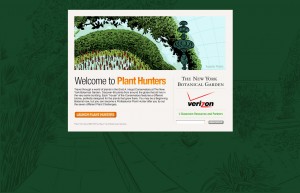 The New York Botanical Garden has launched a new online resource that brings the wonder of its extensive plant collections into homes and classrooms around the world. Plant Hunters is an innovative tool that provides a virtual exploration of Earth’s vast biodiversity inside the Enid A. Haupt Conservatory and serves as a dynamic way for students and families everywhere to discover the beauty and importance of the world’s plants.
The New York Botanical Garden has launched a new online resource that brings the wonder of its extensive plant collections into homes and classrooms around the world. Plant Hunters is an innovative tool that provides a virtual exploration of Earth’s vast biodiversity inside the Enid A. Haupt Conservatory and serves as a dynamic way for students and families everywhere to discover the beauty and importance of the world’s plants.
Plant Hunters combines digital illustrations and interactive games with expert-developed plant science content as an engaging way to teach users about topics such as pollination, plant evolution, and how plants may be used for medicine, food, and shelter. Users can navigate the Tropical Rain Forest and Desert Galleries of the Haupt Conservatory, explore 64 different plants in more detail, watch videos of Botanical Garden scientists, play seven different Plant Challenges, and much more! Learning as they play, kids can progress from a “Beginning Biologist” to a “Cool Conservationist” and finally to a “Professional Plant Hunter.”
Read More
Posted in People, Science on May 25 2010, by Plant Talk
Wayt Thomas Collaborating on Research in Tropical Forests
 |
Wayt Thomas, Ph.D., is the Elizabeth G. Britton Curator of Botany in the Institute of Systematic Botany. |
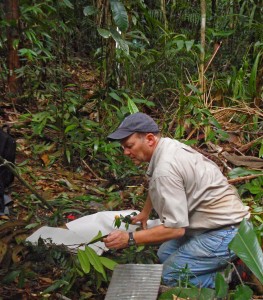 I’ve been studying the flora of the Atlantic coastal forest in northeastern Brazil for 20 years. These forests are one of the world’s “biodiversity hotspots” because of the heavy deforestation, high species diversity, and large number of species that occur nowhere else. Much of my work has been focused on the forests of southern Bahia, near Ilhéus, but I recently was awarded a grant from the National Science Foundation to study the forests farther to the northeast.
I’ve been studying the flora of the Atlantic coastal forest in northeastern Brazil for 20 years. These forests are one of the world’s “biodiversity hotspots” because of the heavy deforestation, high species diversity, and large number of species that occur nowhere else. Much of my work has been focused on the forests of southern Bahia, near Ilhéus, but I recently was awarded a grant from the National Science Foundation to study the forests farther to the northeast.
As you read this, I am again in Brazil, having left New York on May 9. The purpose of my trip is several-fold: to check up on the field work of my student, Daniel Piotto, near Ilhéus, Bahia; to meet with professors at the State University of Santa Cruz in Ilhéus; to travel inland to Jequié, Bahia, to meet with a collaborator at the State University of Southern Bahia; to visit the Guaribas Biological Reserve in Paraíba; and to organize the newly funded project with my Brazilian collaborators, an essential element in field research.
I will file reports such as this one and photos from Brazil as access to the Internet on my end allows.
Read More
Posted in Emily Dickinson, Exhibitions, Programs and Events on May 21 2010, by Plant Talk
 |
Rob Casper is Programs Director of the Poetry Society of America. |
The New York Botanical Garden is in the midst of its exhibition Emily Dickinson’s Garden: The Poetry of Flowers, and the Poetry Society of America couldn’t be more excited!
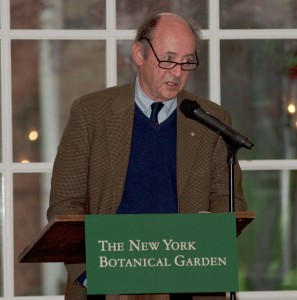 We’ve already had a great pre-launch during Poem in Your Pocket day (covered in this week’s “Talk of the Town” section in The New Yorker), with Mayor Bloomberg, Sigourney Weaver, and New York’s State Poet Jean Valentine. And our first My Emily Dickinson readings featured former U.S. Poet Laureate Billy Collins (pictured), award-winning poet Marie Ponsot, and Dickinson biographer Brenda Wineapple. There’s plenty to come, too, with readings and talks at the Garden by Bowery Poetry Club founder Bob Holman (May 22), scholar Christopher Benfey (June 4), poet and writer Joyce Carol Oates (June 12), former Queens Poet Laureate Stephen Stepanchev (June 12), and others, as well as corollary programs at the Belmont Public Library with a host of younger poets—including Mark Levine (May 27), Catherine Barnett (June 7), and Ada Limon (June 10)—reading from and speaking about the Belle of Amherst. Finally, the exhibition at the Garden will end with a weekend marathon reading of specific themes within Dickinson’s work, for which Garden visitors can sign up to participate in!
We’ve already had a great pre-launch during Poem in Your Pocket day (covered in this week’s “Talk of the Town” section in The New Yorker), with Mayor Bloomberg, Sigourney Weaver, and New York’s State Poet Jean Valentine. And our first My Emily Dickinson readings featured former U.S. Poet Laureate Billy Collins (pictured), award-winning poet Marie Ponsot, and Dickinson biographer Brenda Wineapple. There’s plenty to come, too, with readings and talks at the Garden by Bowery Poetry Club founder Bob Holman (May 22), scholar Christopher Benfey (June 4), poet and writer Joyce Carol Oates (June 12), former Queens Poet Laureate Stephen Stepanchev (June 12), and others, as well as corollary programs at the Belmont Public Library with a host of younger poets—including Mark Levine (May 27), Catherine Barnett (June 7), and Ada Limon (June 10)—reading from and speaking about the Belle of Amherst. Finally, the exhibition at the Garden will end with a weekend marathon reading of specific themes within Dickinson’s work, for which Garden visitors can sign up to participate in!
Read More
Posted in Shop/Book Reviews on May 20 2010, by Plant Talk
 John Suskewich is Book Manager for Shop in the Garden.
John Suskewich is Book Manager for Shop in the Garden.
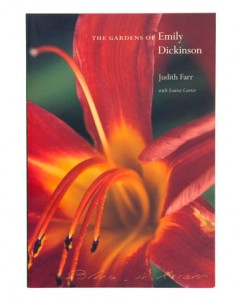 Emily Dickinson was a poet and a gardener, so there is no better place to celebrate the world of words she created than here at The New York Botanical Garden. The exhibition Emily Dickinson’s Garden: The Poetry of Flowers illustrates the many ways in which her horticultural life inspired her poetry, using an evocation of her actual garden, a digital reproduction of her personal herbarium, manuscripts, artifacts, and other material to bring this point into bloom.
Emily Dickinson was a poet and a gardener, so there is no better place to celebrate the world of words she created than here at The New York Botanical Garden. The exhibition Emily Dickinson’s Garden: The Poetry of Flowers illustrates the many ways in which her horticultural life inspired her poetry, using an evocation of her actual garden, a digital reproduction of her personal herbarium, manuscripts, artifacts, and other material to bring this point into bloom.
At Shop in the Garden we are featuring a number of books that show how the poet used plants and flowers as metaphor and image in her art.
The Gardens of Emily Dickinson, by Judith Farr, with a chapter on how to grow Dickinson’s flowers by Louise Carter, is a gardening biography, a florography, of the “Belle of Amherst.” With scholarship and insight, the Farr re-creates the arcadian context of life in small-town America during the mid-19th century, where nature came right up through the picket fence to your front door. The author looks at the poems and letters to see what specific flowers Dickinson gardened with and what specific meanings they had for her. From Indian pipes to jasmine vines, everything in nature could be a symbol. and part of Dickinson’s greatness comes from her ability to distill what she observes into something eternal.
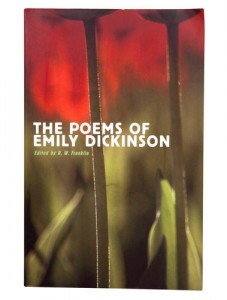 Two volumes of her poetry show with what mastery and beauty she was able to do this. Poetry for Young People: Emily Dickinson, edited by Frances S. Bolin, selects some of the best loved poems and sets them to charming illustrations by Chi Chung. There is an especially good selection of the riddle poems (but why not “A narrow fellow in the grass…”!)
Two volumes of her poetry show with what mastery and beauty she was able to do this. Poetry for Young People: Emily Dickinson, edited by Frances S. Bolin, selects some of the best loved poems and sets them to charming illustrations by Chi Chung. There is an especially good selection of the riddle poems (but why not “A narrow fellow in the grass…”!)
The Poems of Emily Dickinson: Reading Edition, prepared by Ralph W. Franklin, is a definitive one-volume edition of the extant poems, 1,789 in all, presented with Dickinson’s idiosyncratic spelling, punctuation, and capitalization. What a pleasure to have this great achievement concentrated into an object you can bring anywhere. Short of facsimiles of fascicles, this is the Dickinson volume to own.
Shop
Get Your Tickets
Posted in Emily Dickinson, Exhibitions on May 19 2010, by Plant Talk
 |
Jessica Blohm is Interpretive Specialist for Public Education. |
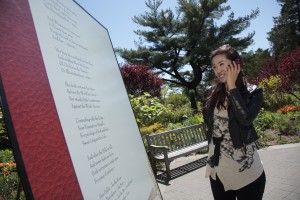 The exhibition Emily Dickinson’s Garden: The Poetry of Flowers features a Poetry Walk, a self-guided tour highlighting 35 of Dickinson’s poems on signs located among the Botanical Garden’s collections, near the plants and flowers that inspired her.
The exhibition Emily Dickinson’s Garden: The Poetry of Flowers features a Poetry Walk, a self-guided tour highlighting 35 of Dickinson’s poems on signs located among the Botanical Garden’s collections, near the plants and flowers that inspired her.
Visitors stroll along Perennial Garden Way—during the peak of spring flowering season—observing Dickinson’s muses such as daffodils, roses, daisies, tulips, and conifers.
An audio commentary, accessible by cell phone, illuminates her life and her love of nature, flowers, and gardens. Providing insight into her poetry are Dickinson experts Judith Farr, Professor Emerita of English and American Literature at Georgetown University and author of The Gardens of Emily Dickinson; Marta McDowell, historic garden specialist, instructor at The New York Botanical Garden, and author of Emily Dickinson’s Gardens: A Celebration of a Poet and Gardener; and Alice Quinn, Executive Director of the Poetry Society of America.
To access the audio tour, look for the audio tour symbol on signs on the Garden grounds. Call 718.362.9561, enter the prompt number noted on the sign followed by the # key.
For instance, enter 515# to hear an explanation of the Dickinson poem below. And enjoy!
I hide Myself within my flower,
That fading from your Vase,
You, unsuspecting, feel for me –
Almost a loneliness.
From The Poems of Emily Dickinson, ed. R.W. Franklin (Cambridge, Mass.: The Belknap Press of Harvard Univ. Press, 1998). F 80b

 What started me thinking about what I call “slow art” is my affinity for “slow food” (I must confess to a McDonald’s fix on occasion). Engaging in the preparation of food is a more meaningful experience for me than driving through a pick-up window or popping something into the microwave.
What started me thinking about what I call “slow art” is my affinity for “slow food” (I must confess to a McDonald’s fix on occasion). Engaging in the preparation of food is a more meaningful experience for me than driving through a pick-up window or popping something into the microwave.